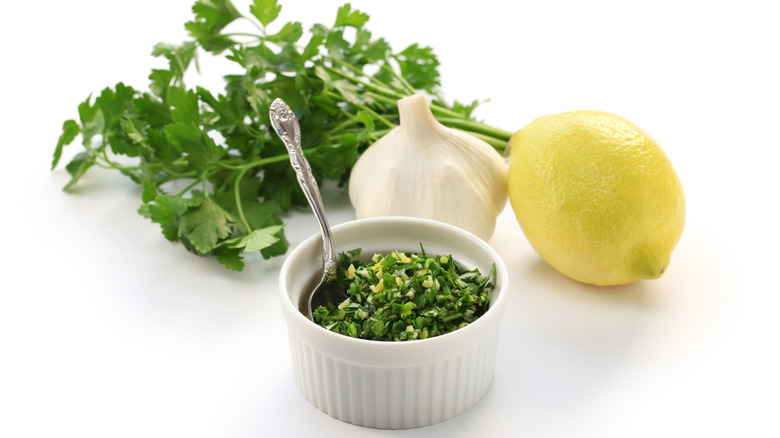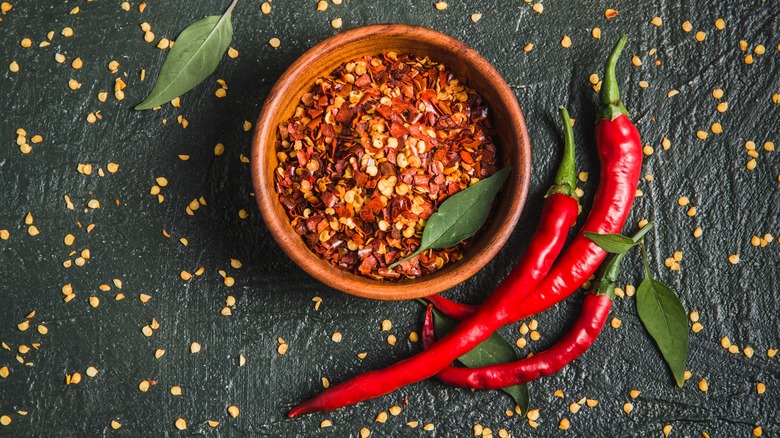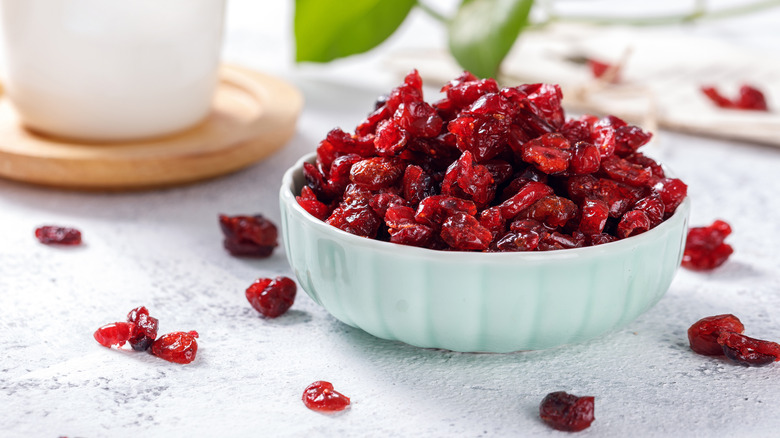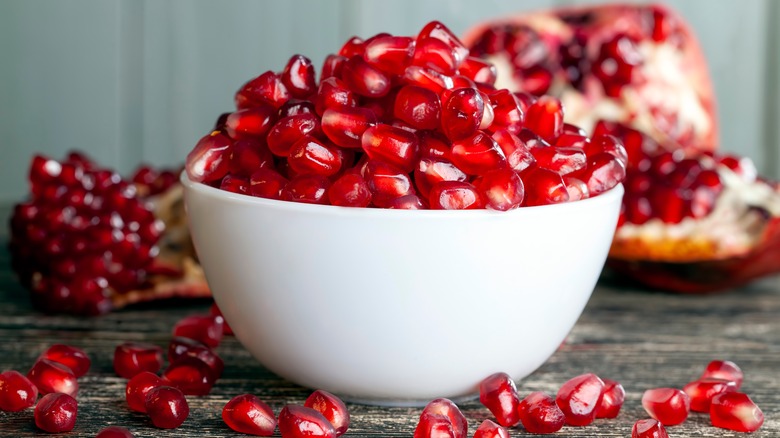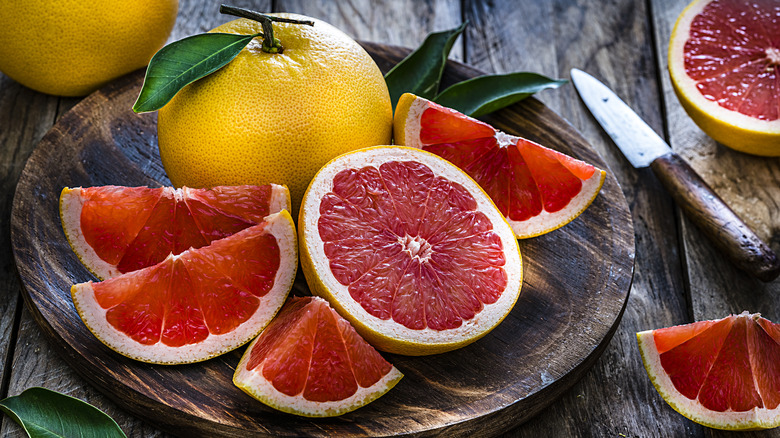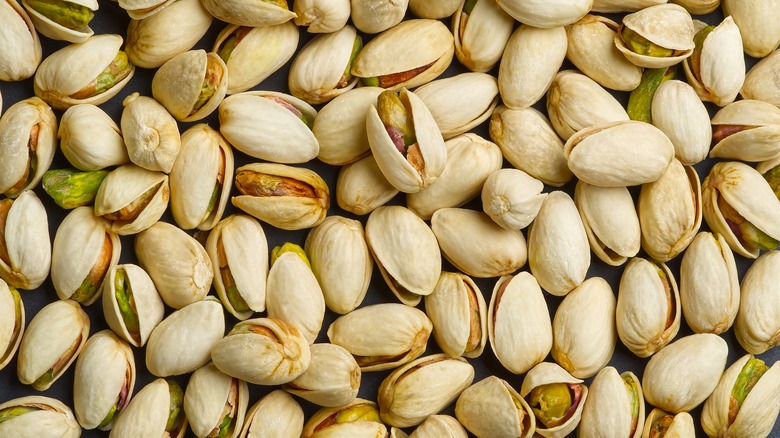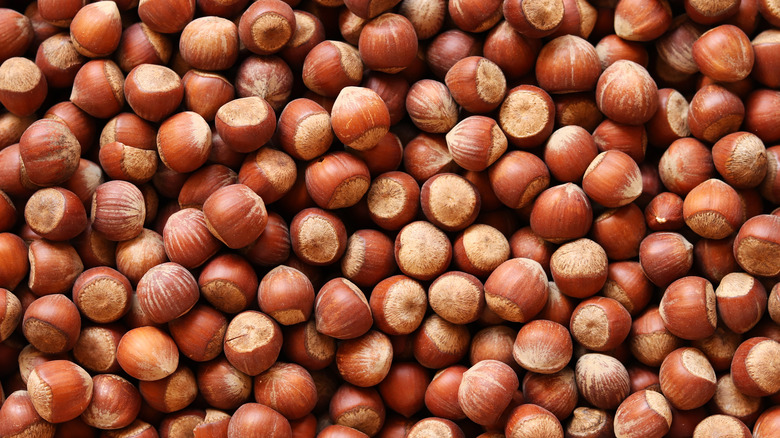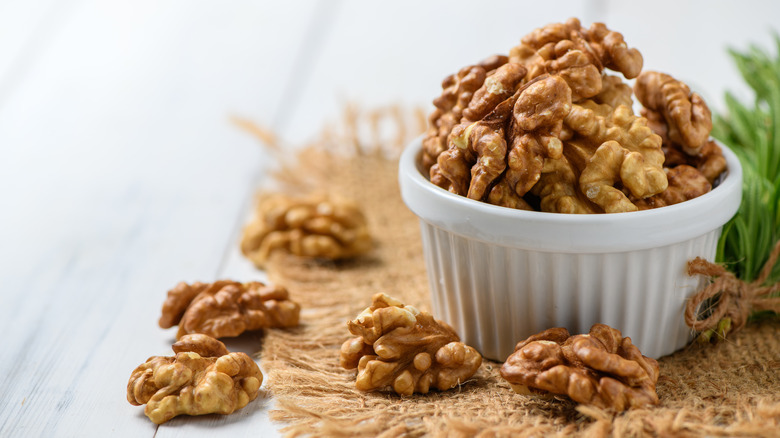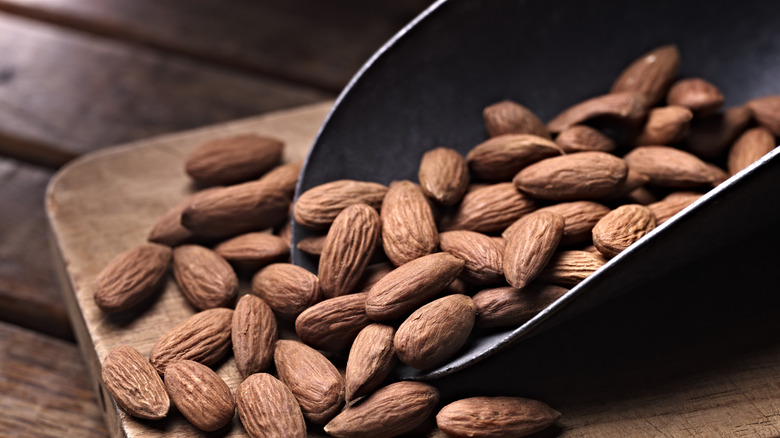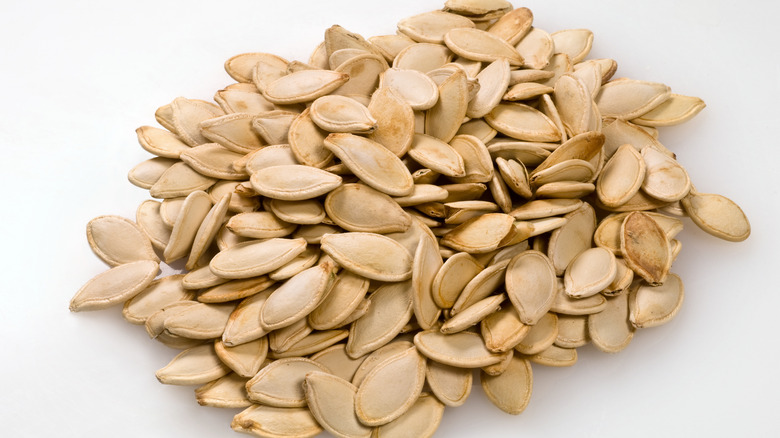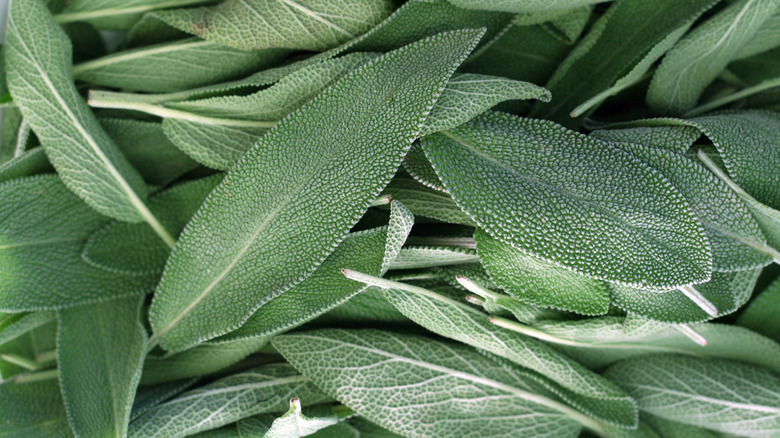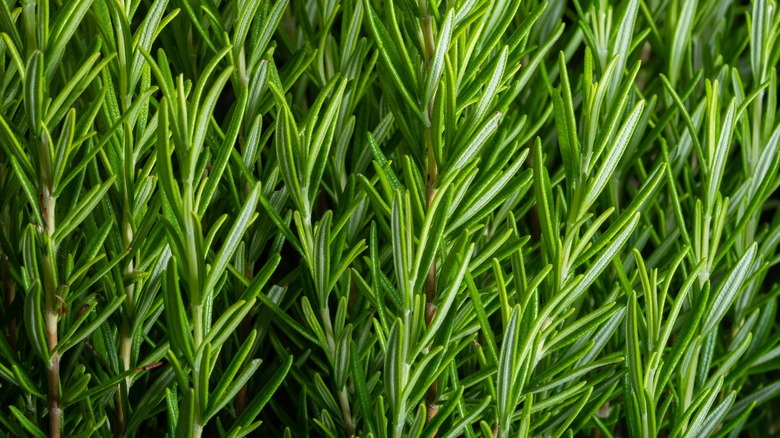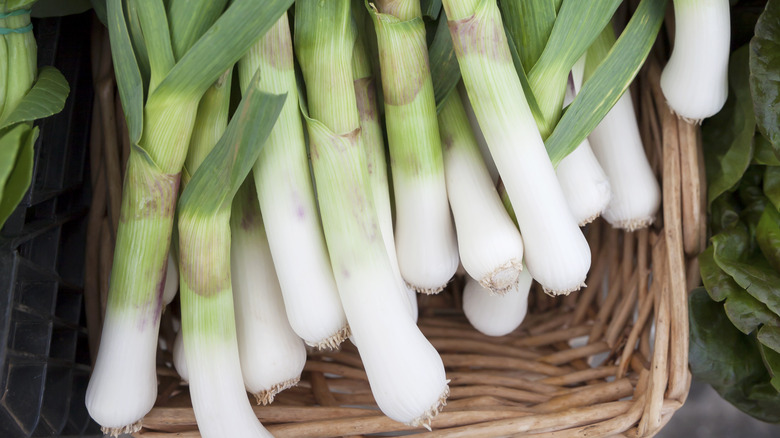14 Ways To Customize Gremolata For Herby Harmony
Gremolata is an aromatic symphony that's traditionally composed of only three instruments: parsley, garlic, and lemon zest. While the origin of this herbaceous Italian condiment is murky, it's believed to have existed for a long time, possibly under different names. Gremolata tastes grassy and zesty, yet can range from savory to sweet depending on your choice of ingredients. You could even say that it's the chimichurri of Italian cuisine. Osso buco alla Milanese, or braised lamb shanks, is a popular Italian dish that's traditionally garnished with grem.
From a flavorful garnish for meats, seafood, and veggies, to a fresh topping on salads and pastas, gremolata's complementary taste makes it an extremely versatile condiment. Its minced herb consistency also works great for blending and spreading. Fresh is best when it comes to herbs because their aromatics are more crisp and pungent. That's why gremolata should be made by hand. With only a handful of ingredients and a few minutes, you can whip up a fresh batch of gremolata in no time.
Another benefit to making it from scratch is that it gives you an opportunity to mix things up a bit. Along with being a versatile condiment, gremolata can be spruced up with a wide variety of ingredients. You can try other types of herbs for new earthy experiences, sweeten the deal with fruit, or even introduce creamy richness with nuts. To help you up your game, we put together a list of ways to customize your gremolata for herby harmony.
1. Chili pepper flakes
A sprinkle of spice can turn an everyday recipe into an unexpected highlight, providing just the right accent. That's what happens when chili pepper flakes are introduced to gremolata. The slight departure down peppery blvd takes traditional grem to new places. Believe us, it's one of the best flavor additions to amp up a classic gremolata sauce. The refreshing zest of lemon and parsley tempers the kick of chili, letting it add just enough zap without overwhelming. The chili flakes are a complementary counterpart to garlic, which is also piquant.
Chili pepper flakes can also be substituted for any number of mouth-warming peppers like jalapeños and cayenne, or you can really turn the heat up with chopped habanero. All's fair in love and gremolata, just so long as you can take the heat. Next time you decide to make a fresh batch, try mixing in a bit of olive oil — it's a quick and easy way to make a sauce and spread. Tradition aside, we highly recommend using it on any and everything immediately.
2. Dried cranberries
Somehow gremolata manages to achieve delicious perfection using only a few ingredients. Whoever invented this herbaceous mixture must've praised the heavens after they figured it out. Such is the human spirit, one of sheer tenacity, especially when crave-worthy results lie at the end of the culinary tunnel. If you think about it, that same tenacious nature probably inspired another great mind to rethink the notion of perfect gremolata, or in other words, to recreate the proverbial wheel, and that's how we ended up with cranberry gremolata.
Dried cranberries are the bittersweet boost you didn't know gremolata needed. If refreshing describes the taste of gremolata, the addition of cranberry can be described as fun. Although this is a nontraditional recipe, it still pairs lovely with traditional dishes like osso buco, a classic risotto, or any food of your liking. Along with providing fruity flare, cranberries are also super healthy. According to WebMD, they're antioxidant-dense and offer several nutritious vitamins with letters from the alphabet. Yup, that's right — cranberry gremolata is easy to make, great tasting, and good for you. What's there not to love?
3. Pomegranate
For some recipes and during certain seasons, you may want to lighten your gremolata with the refreshing addition of fruit. Thanks to gremolata's easy-going flavor profile, it gets along just fine with dried and fresh fruits. We recommend trying pomegranate arils. Those tiny fruit bombs not only add a burst of bittersweetness but also provide a slightly crunchy texture, making the mouthfeel more interesting.
Pairing the zingy flare of pomegranate with the grassy taste of parsley is reminiscent of, yet distinct from, lemon and basil. Tuck in your Meyer lemon beef brisket with a blanket of pomegranate gremolata. If meat isn't on the menu, you can also toss some into your favorite leafy blend with olive oil, salt, and pears. It truly "pears" well with a wide assortment of recipes. All you have to do is remove the pomegranate seeds without a mess, sprinkle some arils in your gremolata, mix it together, and enjoy.
4. Grapefruit
While adding ingredients to customize your gremolata is one way to achieve herby harmony, another way is by substituting traditional ingredients with different ones. Add a citrusy twist by using grated grapefruit zest rather than lemon. It doesn't have quite as much zing as lemon, but it still carries a nice amount of zang. Grapefruit zest is also sweeter too, adding a nice touch of fruitiness. Think of it as a summery take on classic gremolata that tastes great with vegetable dishes.
Livestrong says that there are many benefits from eating the grapefruit peel — like lemon zest, it's loaded with lots of vitamins and nutrients. It's also fibrous, which means you'll be digesting deliciousness with no problem at all. Pour it over a healthy hodgepodge of chopped eggplant, zucchini, red and yellow bell peppers, along with onions and artichokes — you can thank us later. For a hearty springtime dish, try it with seared lamb, burrata, and asparagus. It's a fresh and tasty topping worth talking about.
5. Pistachios
Adding nuts to your gremolata is a great way to balance out its strong herb and citrusy taste. Pistachios, in particular, provide a creamy and toasty earthiness that calms the peppery notes, while adding more richness. It makes the sauce more rustic and sweet; great for topping grilled steaks, lamb or roasted root vegetables, polenta, and minestrone. Pistachio gremolata hits all the flavorful notes you expect while adding a totally new mode to the composition.
This recipe-elevating mixture of gremolata also benefits from the nutrients found in pistachios. According to Healthline, it's a superfood that delivers an explosion of antioxidants, more potassium than bananas, and a whopping 28% of your suggested daily consumption of vitamin B6, which is essential to your bodily function. No matter how you dice your gremolata, trust us, there's no downside, only deliciousness. Looking for an aromatic and saucy getaway, try out this mortadella bolognese with pistachio gremolata recipe. If seafood is more your speed, check out this seriously impressive pan-seared salmon with pistachio-herb gremolata.
6. Hazelnuts
Smooth and buttery, hazelnut is another popular nut that plays well with gremolata. Different from most varieties, hazelnut flavor stands out even when mixed with a full-bodied ingredient like chocolate. The same here applies, except the contrast makes for an interesting balance taste-wise. While gremolata is bright and springy, hazelnut brings to mind evenings around the fireplace. The odd combo somehow becomes both a warm and refreshing recipe topper.
Hazelnut's roasted and sweet tones act as a flavor bridge when used on savory dishes. The charred tastiness of a seared rack of lamb complements the smoky accent of roasted hazelnut gremolata, while parsley's herb and grass-like profile melds perfectly with hazelnut's earthiness. With this surefire ingredient, you can satisfy your stomach and step up your health. According to WebMD, the nutrients in hazelnuts help improve heart health and reduce the risk of cancer. What are you waiting for? You should already be headed to the store to buy the ingredients for this crave-worthy custom grem.
7. Walnuts
Another fan-favorite ingredient worth going nuts over is walnuts. Although they pack fewer calories, proteins, and fats than hazelnuts, according to Foodstruct, walnuts contain more protein and less sugar. As a super versatile ingredient, they're commonly used in a range of recipes, from savory meats and alternative protein substitutes to sweet and cooling summer delights like this grilled watermelon steak dish. The complementary profile of walnut takes well to the divine combination of parsley, garlic, and lemon zest.
If you have a taste for a bit of zest, elevate roasted asparagus with a few dollops of this special mixture, along with a healthy sprinkle of goat cheese. When blended with olive oil, it results in a creamier consistency, making it an excellent sauce or dip for freshly baked bread. You can even mix it into everyday pastas and salads. Trust us, the taste of this gremolata is off the wall-nuts.
8. Almonds
Pairing gremolatas with different nuts is a great way to keep recipes exciting. If you thought that hazelnuts and walnuts were the end all be all, don't worry almond-lovers, we got you covered too! Almond gremolata introduces the toasted earthiness you expect from nuts, rounding out the flavor, while adding a crunchy consistency. When blended, it can be transformed into a sauce worth savoring. It goes great with white and red sauce pastas, steaks, and so much more. Another fun fact about almonds is that they contain more fiber than other nut varieties, and one of the highest amounts of protein, making them one of the healthiest nuts around.
If you love veggies, try it with garlicky green beans or tossed into a lunchtime salad. Matter of fact, just get creative and go wherever your culinary curiosity takes you. You get all the healthy benefits of almonds combined with all the panache of a classic gremolata, it's literally a win-win situation.
9. Pumpkin seeds
If nuts complement gremolata, naturally seeds would as well. Their closely related flavor profiles both offer earthy and nutty tastes. Unlike nuts, pumpkin seeds actually need to be roasted before they can be consumed, which of course adds a touch of toasted goodness. When paired with gremolata, they form a flavorful trifecta of taste, texture, and health. Pumpkin seeds are full of valuable nutrients like antioxidants, iron, zinc, and magnesium as well.
It's easy to cook the pumpkin seeds, all it takes is 45 minutes of roasting, just make sure to toss the seeds around every 15 minutes. Once cooked, crush and blend the pumpkin seeds in with a traditional gremolata recipe, and voilà ... welcome to Flavortown. We also recommend trying it atop honey-roasted butternut squash with capers, as the nut flavor from the pumpkin seeds tastes excellent with its subtle sweetness. You can also spice things up with chopped jalapeños, it goes great with white beans and toast. It comes in handy even during wintery months, it's the perfect garnish for a warm bowl of soup.
10. Sage
Sometimes you gotta break from tradition in order to experience the possibilities. While nothing beats the time-tested taste of a classic parsley gremolata, using different herbs can result in surprising flavor blends. Fresh and aromatic sage is a great herb that goes nicely with parsley and can also substitute it completely. In sage gremolata, chopped garlic helps bring out the savoriness. It's especially tasty when they're flash-fried together before being added to the mix. Sage's distinctive herbaceous taste dances the perfect waltz with strips of lemon zest — they both add lightness to the recipe.
Another great way to spruce up this special gremolata is by using orange zest in place of lemon. It gives it an extra touch of sweetness while still retaining the citrusy kick. Calling all meat lovers! We absolutely recommend lathering this aromatic spread over a freshly grilled ribeye steak. It's also a refreshing pairing with wild salmon, warm and creamy white bean soup, and savory farro risotto.
11. Rosemary
Another way to flip the script on your everyday gremolata is by blending or substituting the parsley with rosemary. Its woodsy evergreen taste is more pronounced than parsley, making an unmistakable impression on dishes. You have to be more mindful when using it though, as its flavor can definitely overpower. It's best to top and taste test until you find the right balance. You'll certainly surprise dinner guests when you serve it atop succulent grilled pork chops. Using it as a garnish on whole roasted cauliflower will one thousand percent debunk the lingering myth that vegetables are boring.
Compared to other herbs, rosemary has a mostly distinct taste, only slightly comparable to marjoram and thyme. Whether you're a gremolata traditionalist or prefer a bit of adventure, we recommend trying this out. You can signal the dynamic duo of parsley and rosemary to rescue a mouthwatering turkey osso buco or sprinkle some love atop a rich beef ragu.
12. Bacon
Bacon might sit near the top on the list of "best flavor-enhancing ingredients." Whether salty or sweet, the cured and craveable meat skyrockets recipes to new heights. That's why it should come as no surprise that bacon and gremolata are a match made in condiment heaven. Whoever discovered this perfect pairing probably received a slow clap after presenting it. It's fresh and tangy, with a savory roundness that works well with hickory, maple, or any bacon flavor of your choice.
Bacon gremolata is a welcomed addition to all of your favorite bacon-friendly dishes (which is pretty much everything). Spoon some over a morning omelet to get the day off on the right foot. You can also get creative and top off your favorite cream-based soup. If you need a quick and easy appetizer, roasted cabbage with bacon gremolata is a surefire hit. There are honestly endless dishes that are long overdue for a level-up with gremolata.
13. Charred scallions and sumac
An ingredient pairing that truly helps gremolata achieve herby harmony is charred scallions and sumac. Charred scallions bring a smokey and peppery kick to the party that fits right in with the chopped garlic, while citrus-like sumac adds a subtle fruity accent. Made from ground dried berries, it pairs well with the lemon, both carrying similar flavor profiles — the only difference is that sumac has a subtle floral quality too.
Sumac is a versatile spice that's typically used on vegetables, lamb and duck, or like lemon, as a finishing sprinkle right before a dish is served. A grilled boneless short rib steak is the perfect playground for charred scallion and sumac gremolata. Sumac's mighty punch cuts through fatty meats without being overwhelming. You'll definitely satisfy every flavorful need by trying it on your favorite meats and fish. Trust us. You should add it to your summer recipe to-do list right now.
14. Anchovies
Probably one of the most unlikely ingredients that'll knock the socks off your gremolata are anchovies. Fishy, salty, and intensely flavorful, you might be surprised to discover why you should start putting more anchovies in recipes. The taste of a cured fish provides a depth to gremolata's lightness, which makes it best for minimal to medium-rich recipes — that is unless itis-inducing food experiences are your thing!
Savory and silver-colored, anchovies aren't to be mistaken for sardines, which are lighter and less rich tasting. Along with being a staple of the famed Mediterranean diet, WebMD says that they're a zero-carb and protein-rich food as well. That means you'll get all of the taste, with none of the trouble. Sauté a few fishies in olive oil, onion, garlic, and herbs for a few minutes before adding it to the grem mix. For a crave-worthy excursion, try dropping some spoonfuls atop a veal osso buco. Make your friends truly salty at the next dinner party by adding capers to the anchovy gremolata. Put it on top of grilled lamb chops and watch — it'll be the topic of spirited conversation around the table.
Static Media owns and operates Tasting Table, Mashed, and The Daily Meal.
